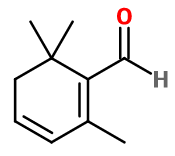
Photo credits: ScenTree SAS
Do you sell any of the raw materials? Would you like to let our users know?
Send an email to fournisseurs@scentree.coto learn about our advertising opportunities.
Do you sell any of the raw materials? Would you like to let our users know?
Send an email to fournisseurs@scentree.coto learn about our advertising opportunities.
General Presentation
-
CAS N° : 116-26-7
-
EINECS number : 204-133-7
-
FEMA number : 3389
-
Density : 0,966
-
Optical rotation : Donnée indisponible
-
Allergens : This ingredient does not contain any allergen.
-
Refractive Index @20°C : Donnée indisponible
-
Volatility : Head/Heart
-
Price Range : €€€€
-
Appearance : Pale yellow liquid
-
FLAVIS number : 05.104
-
JECFA number : 977
Information on synthetic ingredients
-
Acid Value : Donnée indisponible
-
Boiling Point : 70°C (à 1 hPa)
-
Detection Threshold : Donnée indisponible.
-
Molecular formula : C10H14O
-
Log P : Donnée indisponible.
-
Molecular Weight : 150,22 g/mol
-
Fusion Point : Donnée indisponible.
-
Flash Point : 86°C
-
Vapor pressure : Donnée indisponible
Uses
Other comments :
Safranal has a smell quite similar to Ethyl Saranate, both used for their spicy notes of saffron and fruity notes. Nevertheless, the synthesis of Ethyl Safranate is less expensive and is preferred to Safranal.
Stability :
Safranal double bonds gives a risk of polymerisation under the effect of oxydation.
Uses in perfumery :
Safranal is used in fruity notes for its characteristic note and in oriental perfumes, for the addition of a spicy and heady note.
Year of discovery :
First isolation and identification of Safranal was made in 1935.
Isomerism :
Safranal is a constitutional isomer of Thymol and L-Carvone among others, but has a very different structure and smell.
Synthesis precursor :
Safranal does not synthesize other compounds of olfactory interest.
Natural availability :
Safranal was identified in several varieties of black and green tea (see Tea Absolute Colourless). It is one of the components of the fragrant principle of saffron and is present in Wormwood EO. Nevertheless, natural Safranal is not produced for the perfume industry.
Synthesis route :
The synthesis of Safranal has always been problematic. Whatever the production method, the yield of this molecule synthesis has never been high. One of the synthesis that offers a ''good '' yield starts from alpha-cyclocitral. This compound can undergo a bromination with phenyltrimethylammonium tribromide. The obtained intermediate is debrominated to give Safranal, with a yield that is still quite low. Using beta-cyclocitral for this synthesis offers only a complex mixture of molecules, of which Safranal cannot be isolated.
Regulations & IFRA
-
IFRA 51th : This ingredient is restricted by IFRA
-
Restriction type : RESTRICTION
-
Cause of restriction : DERMAL SENSITIZATION
-
Amendment : 49
- Quantitative limit on the use :
-
Cat.1 Cat.2 Cat.3 Cat.4 Cat.5A B C DCat.6 0,0022 % 0,00066 % 0,013 % 0,012 % 0,0032 % 0,0032 % 0,0032 % 0,0032 %0,0073 % Cat.5A B C DCat.6 0,0032 % 0,0032 % 0,0032 % 0,0032 %0,0073 % Cat.7A BCat.8 Cat.9 Cat.10A BCat.11A BCat.12 0,025 % 0,025 %0,0013 % 0,024 % 0,087 % 0,087 %0,048 % 0,048 %No Restriction Cat.10A BCat.11A BCat.12 0,087 % 0,087 %0,048 % 0,048 %No Restriction
Comments :
2,6,6-Trimethylcyclohex-1,3-dienyl methanal has been found in natural extracts but only at trace levels.

